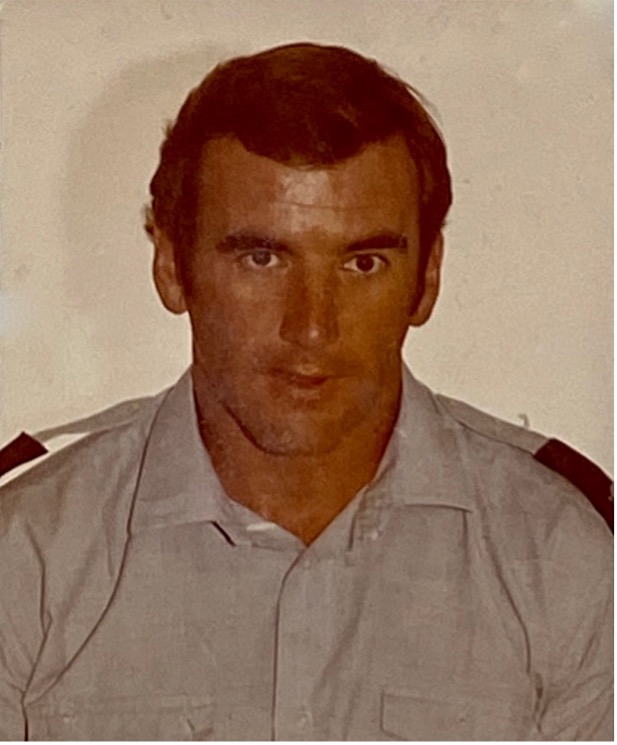
I was born in Northamptonshire, England in 1946.
In 1962 I joined the London Metropolitan Police Cadet Corps. By 1964 I was working in the Information Room at New Scotland Yard where emergency calls were processed. In those days the emergency number was 999 which was the last number on a rotary telephone allowing people to call by feel in the dark. In 1966 I joined Birmingham City Police where I worked on a Plain Clothes Squad that dealt with any criminal offences not handled by the CID which involved such offences as gambling, prostitution, indecency, drugs etc.
In 1970 I joined the Bermuda Police and came out with Pete Treves, Les Pearson, Alan Barker, John Baxter,Terry Warrilow, John Broadbent and Bob Payne.
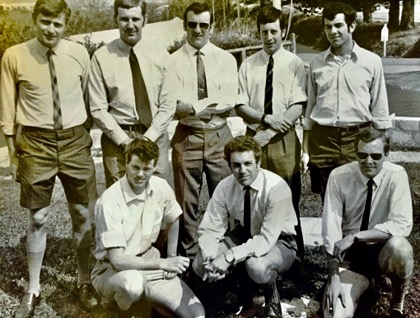
My first posting was to Central Division Hamilton on the beat. Soon after arriving I shared an apartment on the South Shore with Alan Barker and Gertie Cannonier, later I shared an apartment on Flatts Hill with Pete Treves.
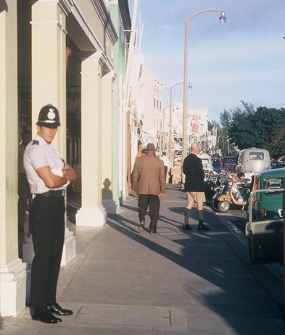
I took up SCUBA diving immediately with instruction from Dave McLeod who ran the Gables Guest House and had a diving operation out of Pompano Beach Club. I was later qualified as a Bermuda Diving Instructor by "Smokey" Wingood, the Bermuda examiner and gave court evidence as an expert witness in SCUBA related deaths on the island.
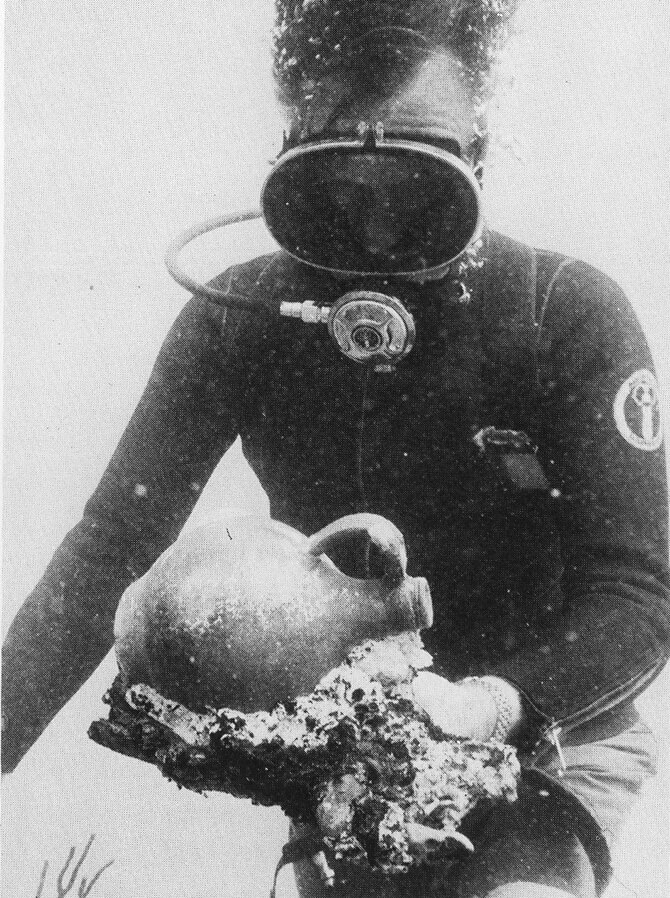 Allan "Smokey" Wingood
Allan "Smokey" Wingood
I took the A, B, and C Maritime Navigation licences that allowed me to operate a commercial vessel up to a 10 foot draught. In April 1971 I was posted to the Marine Section. The following year I was sent to the US Navy base at Key West, Florida with Alex Arnfield for recovery diving training. It was a very arduous military course with many long distant night swims underwater navigating by compass and diving blind in a military harbour and being directed by rope signals. We both qualified as US Navy divers.
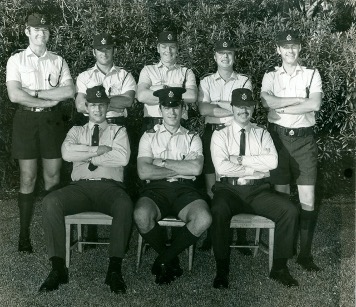
I did the Tug of War team for many years coached by Pat McBride who "overtrained" us so that we became invincible at the Agricultural Fair and after a few years other teams did not want to enter the competition. I remember one year "Super" Lottimore the dog catcher put a black magic voodoo spell on the police team.
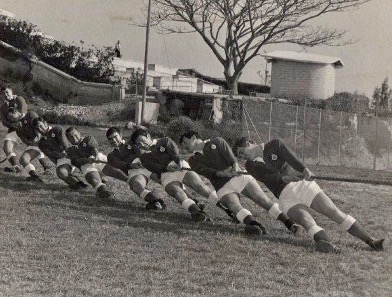
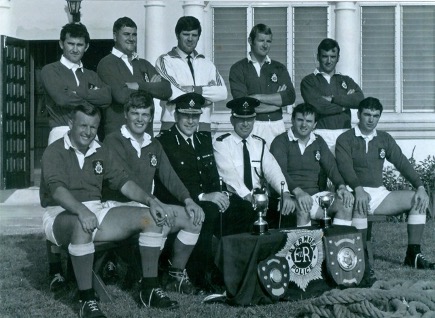 Members of the Police Tug o' War Team display their trophies outside the PRC
Members of the Police Tug o' War Team display their trophies outside the PRCDuring all the 8 years I wreck dived on the outer reefs with Harry Cox every week, I discovered an unknown 18th century wreck on NE Breaker and National Geographic Magazine came down and published an article on the wreck in National Geographic Magazine in January 1977 called "Reach for the New World". I got a research grant from them to go to Washington DC to research the wreck at the Smithsonian Institute. The discovery of the Manilla Wreck was front page news in the Bermuda Gazette entitled "Cox's men haul up a divers dream" by Phillip Dilks. I don't remember the exact date but probably 1975/6.
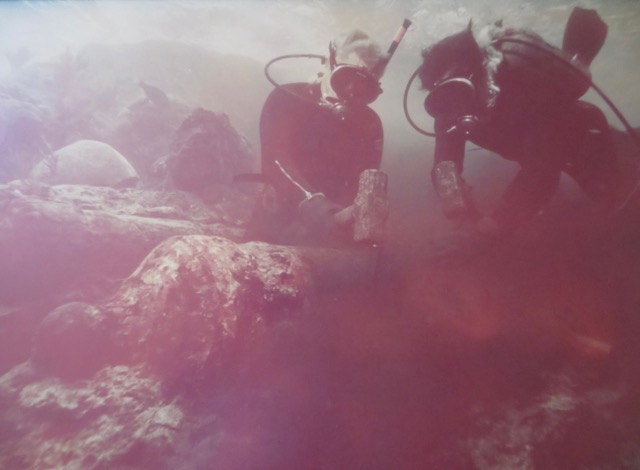 Graham Maddocks (right) and Canadian diver Charlie Dunn
Graham Maddocks (right) and Canadian diver Charlie DunnAs a result of my National Geographic research grant and a lunch with the editor Gilbert Grosvenor I photographed the Tall Ships race for National Geographic when it was held in Bermuda. The National Geographic Assistant Editor Bill Graves visited me several times in Bermuda and wrote to me in Canada. Bill Gillis published a book in 2007 entitled "Reefs, Wrecks and relics Bermuda Underwater Heritage" which detailed some of our diving adventures; the cover photo is from the Manilla Wreck.
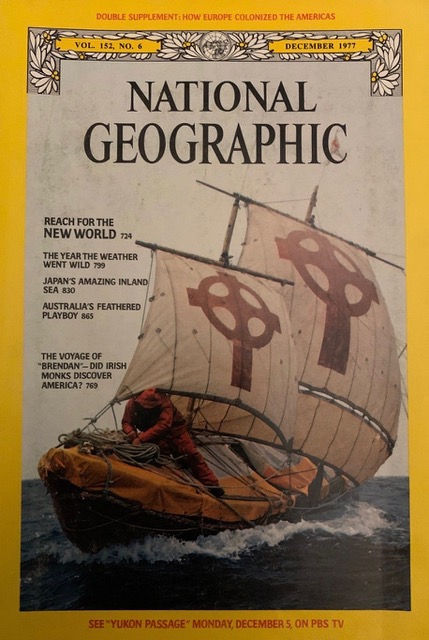
Another passion of mine during my diving days in Bermuda was spearfishing and I went out many times with Brian Malpas and others for lobster and conch as well. They were plentiful in those days.
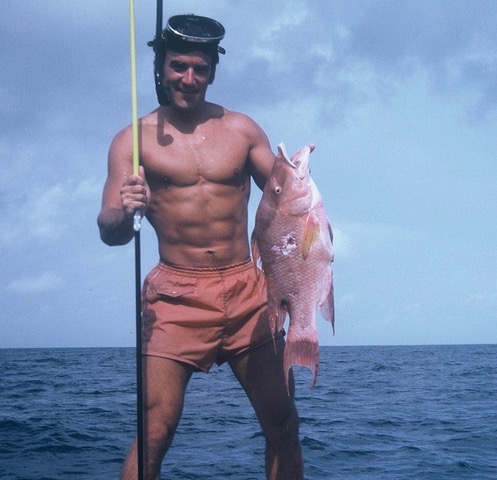 Graham spearfishing
Graham spearfishing
I spent several years as a marksman on the SWAT team run by Tim Willis and as a bodyguard In E department including security for Prince Charles, the Queen, Edward Heath the UK PM, Tito of Yugoslavia and as a recovery diver for Richard Nixon's helicopter flight over water (with instructions to save Nixon and ignore the pilot)
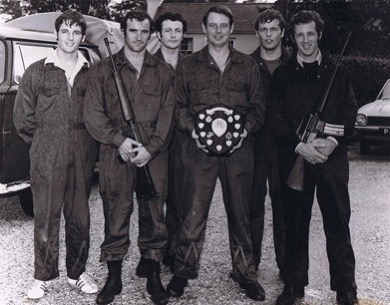
Prince Charles came to Bermuda when he was an officer on a Royal Navy ship in the 70's, a water ski picnic was arranged with some residents and I went along in the police launch to do area security, when the party started water skiing the Royal Navy's launch had terminal engine failure, which put a damper on the whole picnic. I went over with the police launch and offered to take Prince Charles water skiing, he agreed and we had a pleasant conversation and a few laughs. I found him to be a very knowledgeable and decent person well suited to his role. I met Prince Charles on another occasion when he stayed at Government House. I did security outside his bedroom door all night (with an Uzi provided by Tim Willis) and in the morning met him again when we laughed over the water ski trip
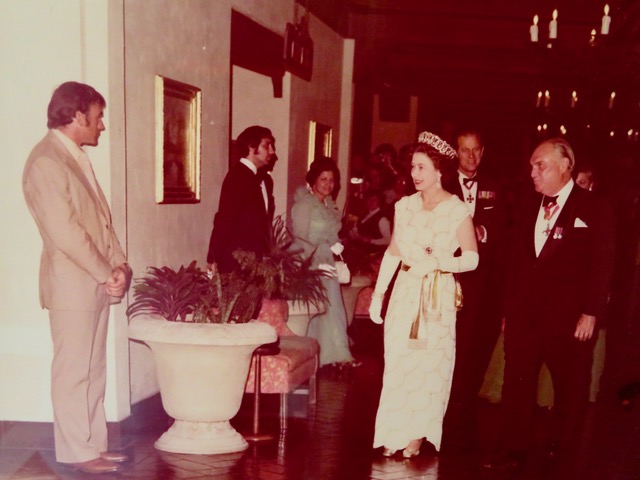
I have a nice photo of myself and John Instone doing security for Queen Elizabeth 11 on a visit to the Southampton Princess Hotel in 1975. This time the Queen came in the Royal yacht Britannia and I was a marksman on the roof of the Bank of Bermuda, below me on another roof was another marksman Mike Chitty, I saw him chamber a round into his M16 rifle (which I thought was unwise as they were very easy to accidentally discharge) after the visit we were picked up and taken to the Club to debrief, sure enough as we took our weapons out of the car Mike Chitty accidentally discharged his M16 rifle into the ground next to my foot (nobody knows about this) I went into the Club and had a triple rum and coke to recover from my near miss!
CLICK HERE for a separate article we published about Graham's encounters with members of the Royal Family - "Rubbing Shoulders with Royalty!"
I read with interest the 2013 book "Justice Denied" by Mel Ayton. I was a bodyguard to the wives of George Duckett and Sir Richard Sharples and got to know them well.
In the Marine Section I often had the opportunity to explore the disused and abandoned Naval Dockyard. On the SWAT team we often trained there, and I was always impressed and intrigued with the potential of these massive old buildings with so much history. I was a founding member of the committee to create a Maritime Museum there. A great deal of work and effort went into this project to get the buildings ready after years of disuse. With the help of "Smokey Wingood" (who had a commercial diving company) I collected many of the artifacts now on display, including large cannons and early diving equipment. We also built a restoration and preservation lab to preserve artifacts that had been under the sea for centuries.
On my last visit back in 1997 I was gratified to see the Maritime Museum now employed 15 people. On this last visit in 1997 I visited with Steve Petty in the Marine Section offices (the old US Navy shore patrol building).
My last years in Bermuda were spent in Central CID under Clive Donald working with Dennis Ramsay and Carlton Adams where we had many good times and made numerous arrests after the 1977 riots.
I left in 1978 and emigrated to Canada where I joined the Victoria Police on the West Coast and did 23 years with some time in the Emergency Response Team (SWAT) and as a detective in the Coordinated Law Enforcement Unit a multi-jurisdictional unit that targeted organized crime by long term surveillance.
Over the years I have visited Willy Hart who was in the gambling police in Las Vegas. Willie (a former embalmer) and I were bodyguards together and covered Richard Sharples' funeral.
Les Pearson and his Bermudian wife who ran a supermarket in Smoky Lake, Alberta and Pete Treves in Carmel, California, and Alex Arnfield came to visit me in 1990 when I was in the Coordinated Law Enforcement Unit.
Hugh Davidson also visited me once.
A few years ago I was in St Vincent and called Norell Hull (we walked the beat together in 1970)
I visited Pete Treves in California every 5 years until his death last year. He was the Best Man at my wedding in Carmel, California in 1978, my marriage to a wife from Monterey, California who was working at Newstead Guest House lasted 10 years
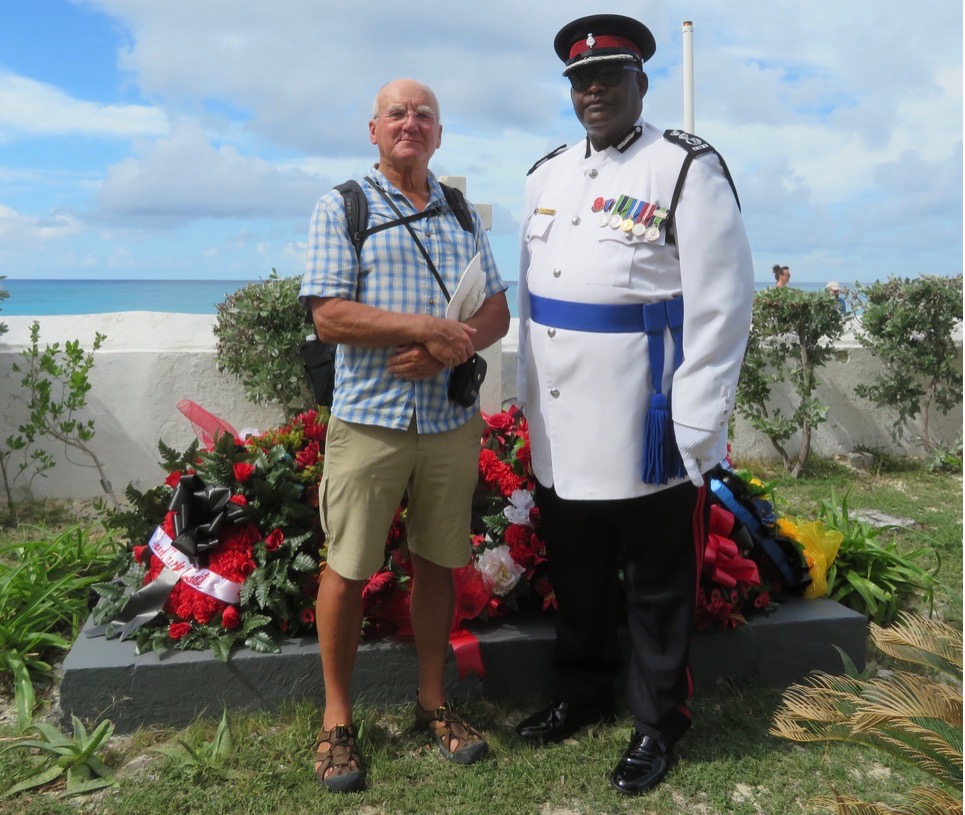
I was recently in the Turks and Caicos Islands and on Grand Turk I attended a Remembrance day ceremony where I introduced myself to the Deputy Commissioner of Police who said "Do you know my cousin Carlton Adams ?". I said, " Of course I do, we worked together in Central CID in the 70's.and had a lot of laughs and good times"
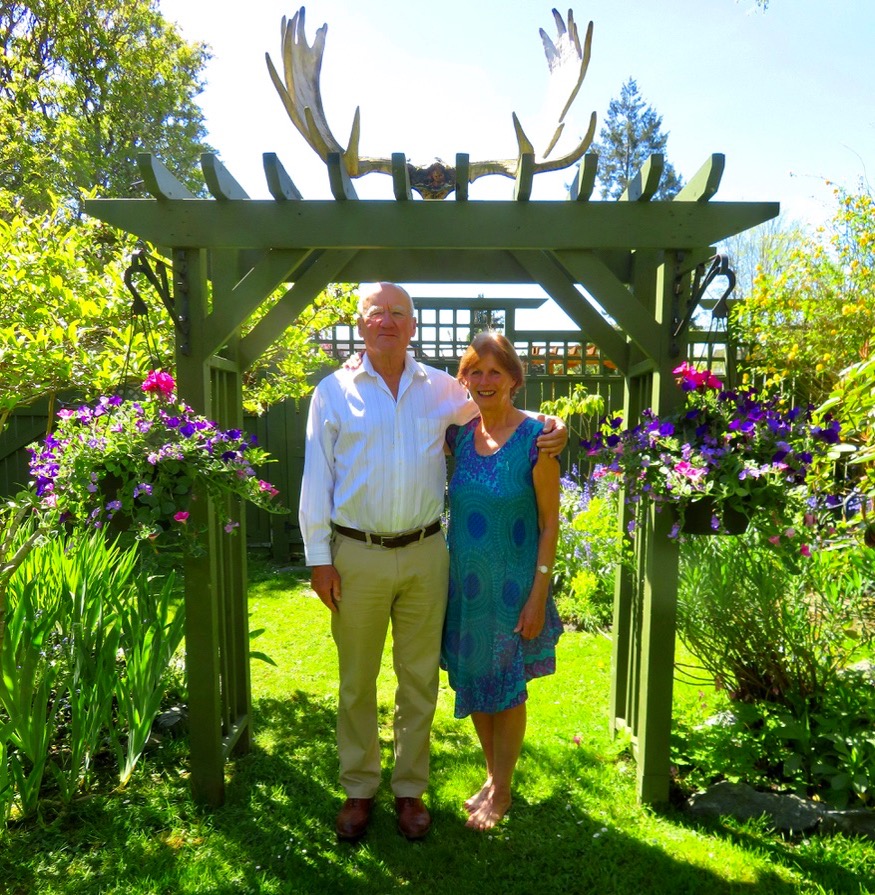
I now live in Victoria, British Columbia, which is a very pleasant small city on the West Coast of Vancouver Island that has a temperate Mediterranean climate and wonderful access to the wilds of Canada. I have been retired for over 20 years and indulge my passion for travelling 4-5 months a year to Africa, Asia, South America, South Pacific, Australia etc. At 77 years old I still ski helicopter assisted in the Rocky Mountains every spring and belong to an active Mountaineering Club.
The moose horns in the photo with my partner Liz in our garden are from my moose and caribou hunting days in the vast north of British Columbia.
There will always be a place in my heart for Bermuda and I have many treasured memories fond memories that I would not trade for anything.
"The story of the sinking of the "Ramona" reminded me of several maritime anecdotes from the 70's."
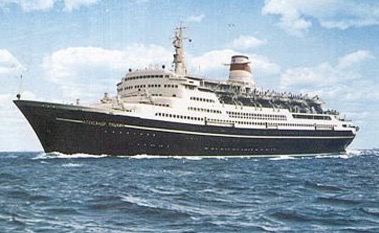 Alexander Pushkin
Alexander Pushkin
He was not a passenger but an American Merchant Marine Cadet, With no further evidence he was let go.
There was no call to Marine Section but we heard about it over morning coffee and Alex Arnfield and myself decided to do an underwater search for the bag.
Several years before a Royal Navy diver Commander "Buster" Crabbe had been hired by M16 to survey the hull of a new Russian warship docked in the UK, he disappeared and his decapitated body washed up days later.
With this in mind we went onboard the ship and tried to explain to the Russian crew that we were not spying on their ship. The crew was unhelpful (and pretended or did not understand or speak English).
With some trepidation we dove under the ship and eventually found the bag, it was very surreal as there was only about 4 feet of water between the ship and the bottom. We sat on the bottom under the giant propellor and went through the bag. It contained many bags of marijuana and a loaded revolver. The boat, with the cadet on board (who had been onboard the "Alexander Pushkin '' selling marijuana to the passengers) had already left the island. But we pursued it in the police launch and pulled it over and boarded. I explained what had happened to the captain and he handed the cadet over and he was arrested and charged and got a 3 month sentence in Casemates.
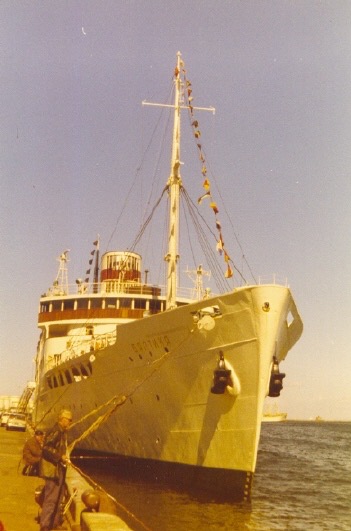 Baltika
Baltika
They were so focused on spying that they ran aground on the reef and were stranded. We inspected the scene in the police launch but the Russians would not let us board. We later took the Attorney General out to negotiate a salvage agreement as the ship was in Bermuda territorial waters. The agreement was called "No Fault No Pay" which meant that if the Bermuda tugs salvaged it they would get a portion of the value of the ship but if they failed there was no cost to the ship. The Russians threw a rope ladder over the side and Alex Arnfield and I, with the AG, went to the Captain's cabin.
The Russian Captain was sweating profusely as he knew he was headed for a Siberian Gulag. He opened a bottle of excellent vodka and handed out Cuban cigars. To ease the delicate negotiations we drank several toasts and puffed the cigars. Even with the aid of an interpreter the lengthy negotiations were going nowhere and the Captain opened another bottle of vodka on his desk.
By the time the AG decided that the Captain had no intention of letting anybody near his ship (for obvious reasons, there were large domes on deck containing listening electronics that were surrounded and camouflaged with trucks) the AG was too inebriated to stand and could not manage the rope ladder over the side. The Russian crew rigged a bosun's chair and he was lowered onto the deck of the police boat. The police crew was not in much better shape but we delivered the AG back to shore.
A day later another Russian "freighter" appeared and tried to tow the "Baltika" off the rocks to no avail.
Within a few days a massive Dutch salvage tug appeared but as the wreck was in Bermuda waters they could not salvage without the AGs permission. Then a third Russian "freighter" appeared and the two Russian shps pulled steel ropes in tandem with the "Baltika" in full power reverse, all to no avail.
By now there was concern that the ship would break up and dump its oil on the reef. The US Navy relented and towed out a fuel barge which was filled with the "Baltika's " fuel oil and on a high tide the two Russian ships pulled her off the rocks. She sailed away with her secret cargo intact.
We were stunned several weeks later to see this yacht sail into Hamilton harbour. Unsure of what to do we consulted the Harbour Master (a wartime submarine Captain) who found a clause in an obscure British Merchant Shipping Act (Bermuda still being a direct Colony) that gave us authority to seize the ship and its crew, which we did. The crew was deported, and got 4 years in the States and given Bermuda's long history of Privateering we kept the boat as a Marine Section prize.
We sailed our prize around the Island several times and once ran over a fishpot and tangled the propeller. We had Supt McMaster on board and I asked him to be in charge of the keys to ensure that no one started the engine while I was holding the propeller. Eventually the yacht was sailed back to the States with a Marine Section crew and was given to the US Coastguard Academy (whose claim was apparently greater than ours).
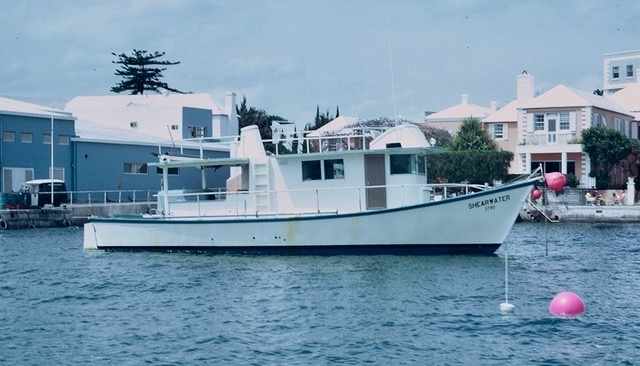
The Marine Section was tasked to find the guns and we started to look in this spot off St Davids Head. The "marked" spot was in deep water, about 120 feet and the bottom was very rocky and full of nooks and crannies. We devised a system of towing a diver with a paddle board that could be used to "fly" up and down to examine the bottom. The chance of finding something as small as a gun was next to impossible. I did find some military ordinance that had been dumped when the British Army pulled out in the 50's, some Mills 36 hand grenades. I brought one back to HQ (not a good idea) to prove we were looking. Inspector Waddell took charge of it and kept it in a bucket of water in his office.
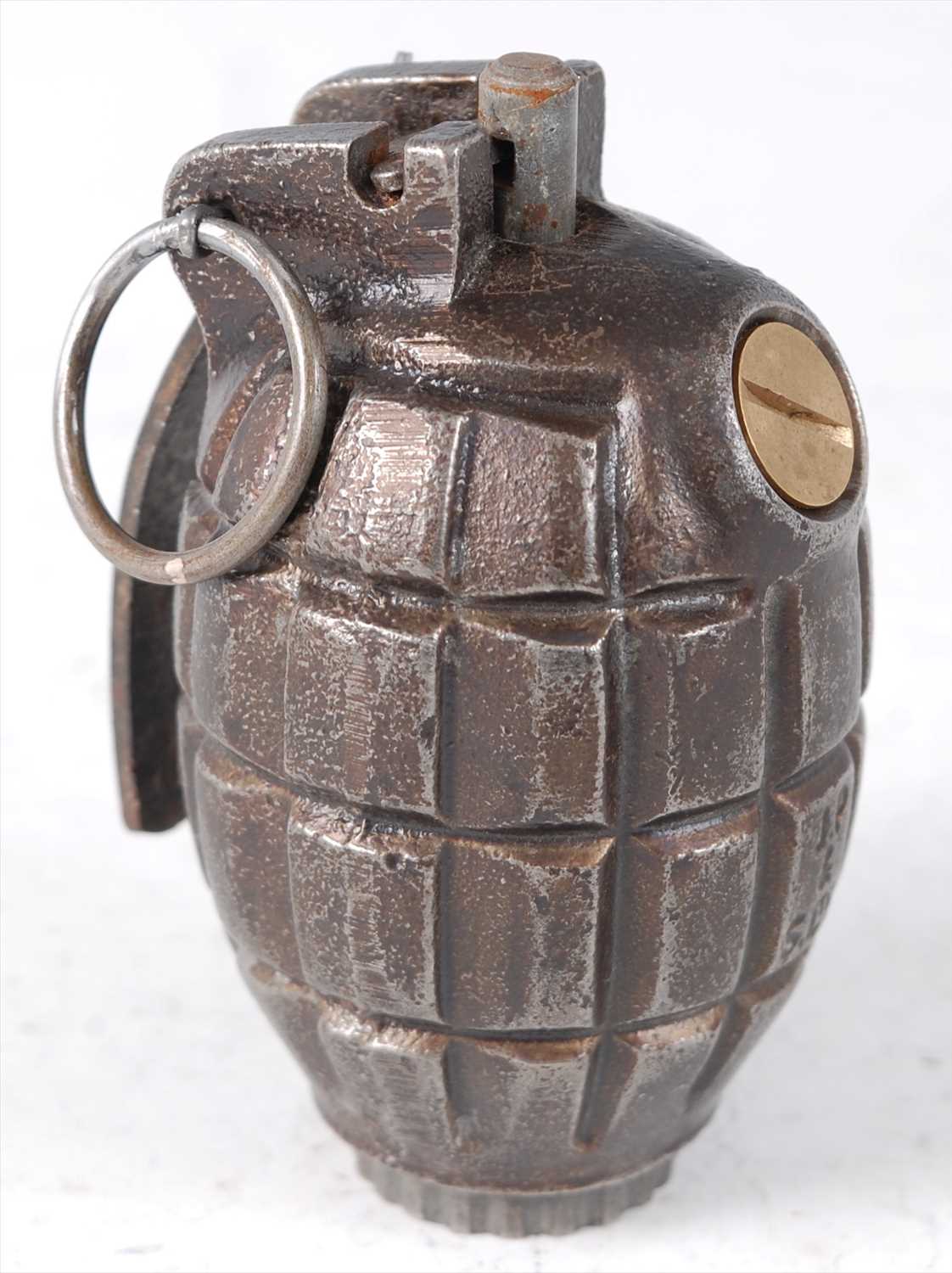 Mills 36 Hand Grenade
Mills 36 Hand Grenade
After a hopeless and fruitless search I informed the powers at the top that it was unlikely the information of the marked spot was true and that it was impossible to find such small objects in such a large area. However, they were not satisfied and someone decided to call the US Navy who would have access to a metal detector.
Eventually 4 US Navy divers came to Bermuda on their way back from mine clearing in the Suez Canal after the 1973 Arab Israeli War. They had mine detectors that gave a signal near metal. We took them out in the police launch and had several dives and tests and found out that for the mine detectors to find something as small a mass as a gun you would have to be very close. After many dives they agreed it was an impossible task.
However, this time I was not so quick to report failure and we continued to dive on likely wreck sights using the mine detectors to find hidden shipwrecks. When a ship sank with many iron cannons on board the reef would grow over it and there was nothing to see but there was a large mass of metal that could be detected. For instance on the "Manilla" Wreck ( the subject of the 1977 National Geographic article, so called because the presence of hundreds of bronze manillas, slave trade money shaped like a bracelet) there was nothing to be seen, but it took 18 months to cut a trench in the reef with hammers and chisels to reveal 22 iron cannons and one bronze Dutch West Indies Company cannon.
We found several promising sights where there was a strong reading of a large mass of metal but nothing to be seen on the reef. These spots were marked by triangulation points on the island and by driving a crowbar marker into the reef where the metal signal was the strongest.
But in the passage of time other things came up and I never did get back to many of these spots.
There are still plenty of secrets on the Island yet.
EDITORS NOTE
As stated earlier, following publication of Graham’s article in our “Then and Now” column, I contacted his old Marine Section and diving partner, Alex Arnfield, to see if Alex had similar recollections about their adventures in Marine Section. I should say from the outset that these two young men were legendary as super fit divers and super fit policemen. The following provides brief details of Alex's time in the Bermuda Police together with his recollections of his time with Graham in Marine Section, as divers on the most rigorous US Navy diving course, and the years they spent diving with another legendary Bermudian diver - Harry Cox.
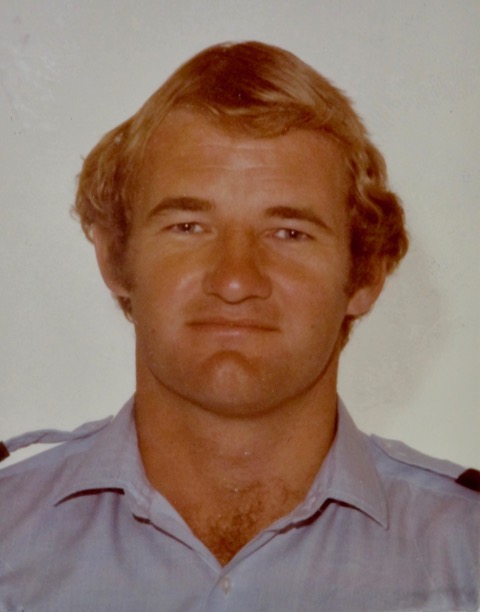 P.C. Alex Arnfield
P.C. Alex Arnfield Alex joined the Bermuda Police in January 1968 after serving as a Cadet and then as a P.C. in the Manchester City Police from 1963-1968. After spells in Western Division (Somerset), Central Division (Hamilton) and Operations (Traffic), Alex was posted to Marine Section in June 1970 and spent most of the next 7 years there. Alex went on to serve in “E” Department, C.I.D., and Narcotics where he was promoted to Sergeant, and served in both Eastern Division (uniform) and Central Division, before retiring from the BPS in 1993.
Alex’s incredible fitness made him a natural for our tug o’ war team CLICK HERE to read more about our unbeatable Police Tug o’ War Team.
Here are Alex’s comments about Graham’s article and the time they spent together on and under the Bermuda's waters:-
"Graham is quite a character and there is no doubt we had interesting 'adventures' when in Marine Section on the old police boats. I read his article with interest and his various anecdotes bring back lots of memories.
Some of incidents he mentions I remember in detail but some of the details vary slightly, probably due to me being in my 77th year too! I always thought Graham would have done well in the armed forces / SAS as he was definitely the type.
It was a great life on the police boats and we covered everything in a couple of old wooden boats in the territorial waters of Bermuda which included several hundred square miles of reef extending out to Argus and Challenger Banks. We only had about six members in the unit with 'Captain' Dave Garland in charge and we were free to roam and take on any emergency on the water.
We had limited resources but had a very good reputation in those days and I believe the boating community appreciated our efforts.. We did some good work and enjoyed being young and fit, and outdoors in a very large area of the Bermuda which we had mostly to ourselves.
COP George Duckett arranged for Graham and I (when attending a senior Admiral’s party at the NAS base) to go to Key West in 1971 to complete what we thought would be a nice jaunt, to learn to dive with the US Navy. COP Duckett apparently wanted a BPS diving section to recover bodies etc. All was arranged over cocktails. The US Navy were happy to foster good relations and help Bermuda and so off we went to Florida.
We were training with some serious US servicemen (during the ongoing Vietnam conflict.) The course was to train SCUBA divers who could contribute to the war effort. Seemed like a fun adventure but all became clear upon arrival in Florida.
I have never done so many press-ups in my life and the whole idea was to break you by creating panic situations with the intention of thinning out the 32 who started the course to find the few who could cope with pressure situations under water in a war setting. As divers know, panic kills more under water swimmers than anything else.
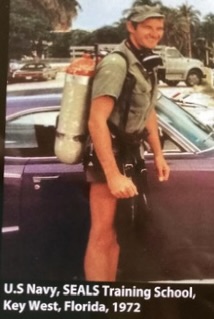 Alex ready for action!
Alex ready for action!
Everywhere we went on base we ran as a squad with a big grey USN ambulance ambulance following and sometimes 'doubles' 84lb air tanks on our backs. I believe 17 of us out of 32 made it to the end of the course. Graham Maddocks came 6th, I was 7th. We were competing with servicemen from the US Marine Corps , submariners, officers from Taiwan (who were expecting to be invaded by China at any time, and this was 50 years ago), also an older man in his 40's, CIA, very quiet and secretive but seemed really old to us!
I know I finished in the best shape I’ve ever been in.
When back in Bermuda I could run up and down Horseshoe all day without breaking a sweat.
The U.S. Navy SEALS diving school was where they weeded out the weakest for dodgy jobs off subs, under ships and creeping up Vietnamese beaches on night operations.
Not sure if I would ever have made the final cut in the more rigorous courses as Vietnam was a serious business, although I'm sure Graham would have as he was a real 'warrior' type, in other words a little 'kamikaze”!
They dropped us off landing crafts, off the hinged front, with no lights, miles offshore in the Florida Straights with double tanks - and snorkels not allowed. All we had was a compass bearing. We swam in to a marker on the beach, miles away, eventually! We had to navigate with compass and if you surfaced to find where you might be, you were disqualified and taken into the ambulance and off barracks and RTU. (returned to unit.) If you missed the landing spot the ambulance took you back to barracks, never to be seen on base again!
We went as a bit of a jaunt as we already were divers in Bermuda, obviously experts! Big mistake, mentioning that to the OIC of the course. The US Navy thought differently. Could run and do press-ups all day at the end of the course.
The training involved trying to create panic by blacking out masks, turning off air supply, as the theory was, you always had to trust your diving 'buddy' at all times and be inseparable. The theory was one of you always had air therefore you could share, and not die.
The worst exercise I can remember was pulling myself down in the carrier dock, at Key West, about 60’ with two diving bells on the way down where you could get a breath then continuing down to the bottom where it was promised there would be air. All done in complete darkness with a blacked out masked.
A little difficult to keep going on down, in the dark, on the promise of a breath of air at the bottom.
At the bottom, take a breath and two instructors held on to your belt and you ascended with them punching your stomach in order to remove excess air which had been inhaled at 60’ therefore if still in the lungs could cause serious problems, or worse. A few of the lads went into the ambulance after that one!
I can see how camaraderie and trust exists in the US Marine Corps and other branches of the US Navy.
We were so fit that when we returned to Bermuda, (where diving is generally very pleasant with clear visibility and no ambulances following) the US Navy invited others of the BPS to attend the course, but no takers after hearing our tales of what we went through!
I remember, upon returning to Bermuda, Graham and I did a single tank dive off "Shearwater" at Argus Bank, 200' on air. Absolute madness as you should never go deeper than 100' on air.
I discovered I hadnarcosis standing on the bottom and fortunately kicked off and finned up until it cleared. Graham was ok of course.
We had some fun and 'adventures' and years of diving with Harry Cox and his crew. He was a great character and we must have explored hundreds of wrecks, some with National Geographic staff and photographer David Doubilet whose fantastic career I followed for many years through the pages of National Geographic.
Sadly, we also saw more than our share of tragedies at sea while serving in Marine Section including night-time searches for victims of boating accidents or drownings.
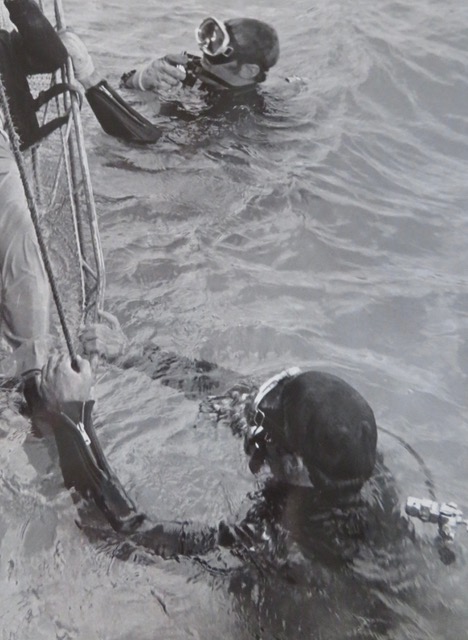 Alex and Graham recover the body of drowning victim
Alex and Graham recover the body of drowning victim
We sure were young and sometimes, foolish!
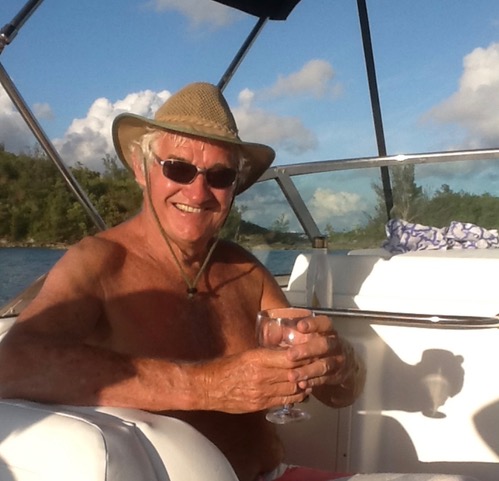 Alex finally relaxing on the water
Alex finally relaxing on the water
My service in Narcotics followed, but that is another story!
My wife Margaret and I still reside here in Bermuda and spend our summers in the cooler U.K. and the Isle of Man.
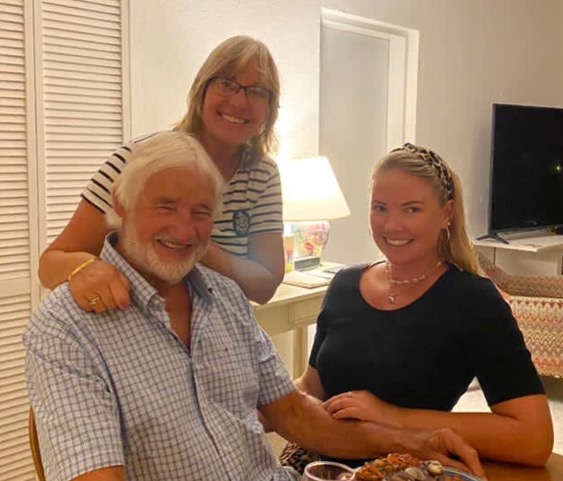 Alex and Margaret with their daughter Katherine
Alex and Margaret with their daughter Katherine
We have one daughter Katherine, who was Miss Bermuda in 2013, and went to Bali to compete in the Miss World competition. She was one of the youngest to compete at 17 and did Bermuda proud.
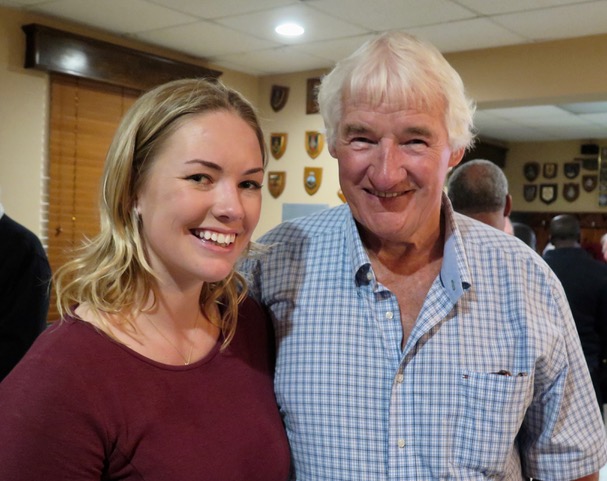 Alex and Katherine at one of our ExPo receptions
Alex and Katherine at one of our ExPo receptions
Katherine graduated in Business at University of Kent at Canterbury and is following a career in IB."
Best wishes to All.